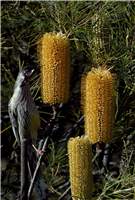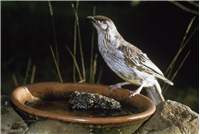Family
Meliphagidae
Genus
Anthochaera
Species
carnunculata
Threats/Control Methods - Regional
This species is threatened in areas where the number of tall trees is declining.
Threats/Control Methods - Local
This species is thriving in Canberra's suburban environment, making use of plentiful nectar sources and nesting sites in gardens and parks.
Local/Urban Actions
Gardeners can replace weed species with native nectar-bearing trees and shrubs, like grevilleas or banksias. Fruit trees can be protected from these birds by netting or sound and visual deterrents.
Common Names
Barkingbird, Butcherbird, Gillbird, Gilly Wattler, Mttonbird, Wattlebird, Wattled Honeyeater, What's-o-clock
Distinguishing Features
The Red Wattlebird is among the largest of Australian honeyeaters at 32-36cm in length. Their plumage is deep brownish grey with prominent white streaks and a yellow belly. Its name refers to the distinguishing reddish lobes of skin called 'wattles' on the side of the neck. The face is pale and the tail is long with a white-tip. Young Red Wattlebirds are duller than adults and have a brown, rather than reddish, eye. Their 'wattle' is also very small and pale in colour.
Survey Techniques
Call and visual identification.
Species Call
Distinctive but unmusical coughs, a harsh 'yac a yac' and a loud 'chok'.
Similar Species
The Little Wattlebird (Anthochaera chrysoptera) is without the red wattles and yellow underparts, and has chestnut wings. The Red Wattlebird is the same size as the similarly behaving Noisy Friarbird (Philemon citeogulis), however, in flight, the black head of the Friarbird distinguishes the two species.
Distribution
Its range extends throughout the southern areas of the Australian mainland.
Country of Origin
Australia.
Conservation (Pet/Pest) Status - Regional
Numbers in the ACT have doubled in the last 20 years, probably due to the greater year-round availability of food in the area (COG).
Conservation (Pet/Pest) Status - National
Secure, not listed under the EPBC Act 1999.
LSCCES Population
High numbers were found across most of the catchment, excluding the areas in and around Black Mountain.
Associated vegetation community
They occur naturally in native forests and woodlands of southern Australia and are common in urban parks and gardens.
Limiting Resources
This species is highly water-dependant, with numbers decreasing with distance away from permanent water bodies. They also require tall trees for feeding and breeding.
Breeding
The breeding season runs from July to September in the Canberra region. A breeding cycle lasts for between 10-12 weeks, with some pairs nesting twice a season. The nest is a saucer built in trees from twigs and dry grass, 2-15 metres from the ground. Incubation of the blotchy, creamy pink eggs takes about 15 days. The 2-3 offspring spend 15 days in the nest, with both parents sharing rearing responsibilities.
Behaviour
They are noisy and aggressive in defending their food sources and nesting sites, often dominating over smaller local honeyeaters. This species will travel across its range and moves out of the high country over winter, travelling in large, silent flocks.
Functional Group
Food Species
The Red Wattlebird feeds on nectar, which it obtains by probing flowers with its thin curved bill. They are especially drawn to gardens containing banksias, callistemon or grevilleas. Some insects are also eaten, taken either from foliage or caught in mid-air. They will also feed on soft, suburban grown fruits like peaches and plums.
Predators
The Common Koel (Eudynamys scolopacea ) may visit the nest of the Red Wattlebird, pushing out its young.
Interesting Fact
Historically, humans hunted these birds, as they were known as the 'best eating bird in the bush'.
References - (reader suitability of references, P=Primary teachers, S=Secondary students, T=Tertiary students and researchers)
Books:Longmore, W. 1991. Honeyeaters and their Allies of Australia. CollinsAngus & Robertson Publishers Australia. NSW. P, S, T
Morcomber, M. 2000. Field guide to Australian Birds. Steve Parish Publishing, Archerfield. P, S, T
Veerman, P. 2003. Canberra Birds: A report on the first 21 years of the garden bird survey. Philip Veerman and Canberra Ornithologists Group. Canberra. S, T
Internet: Birds in Backyards. 2006. [online]. Available at:http://www.birdsinbackyards.net P, S, T
Canberra Ornithological Group (COG). 2004. Birds of Canberra Gardens. COG and the ACT Department of Urban Services. [online]. Available at:http://garden.canberrabirds.org.au/
Online Publications:Nix, H. and Cunningham, R. 2006. Birds of the Lower Sullivans Creek Catchment, Canberra ACT. Prepared for the Life in the Suburbs project using data from the Lower Sullivans Creek Catchment Ecological Survey (LSCCES). Australian National University. Canberra. [online]. Available at http://www.lifeinthesuburbs.com.au/category.php?id=65 S, T
Olsen, P. and Weston, M. 2004. The State of Australia's Birds 2004: Water, wetlands and birds. Birds Australia. [online]. Available at: http://www.environment.gov.au/biodiversity/publications/birds-04/threats.html S, T


 Top
Top Top
Top